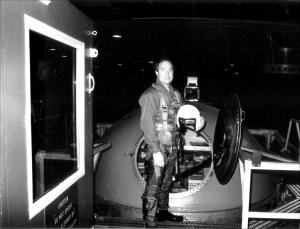Blood pressure is not the only silent medical killer. Hypoxia is also, and unlike chronically elevated blood pressure, it cripples within minutes, or seconds.
Hypoxia, a condition defined by lower than normal inspired oxygen levels, has killed divers during rebreather malfunctions, and it has killed pilots and passengers, as in the 1999 case of loss of cabin pressure in a Lear Jet that killed professional golfer Payne Stewart and his entourage and aircrew. Based on Air Traffic Control transcripts, that fatal decompression occurred somewhere between an altitude of 23,000 feet and 36,500 ft.
In most aircraft hypoxia incidents, onset is rapid, and no publically releasable record is left behind. The following recording is an exception, an audio recording of an hypoxia emergency during a Kalitta Air cargo flight.
Due to the seriousness of hypoxia in flight, military aircrew have to take recurrent hypoxia recognition training, often in a hypobaric (low pressure) chamber.
As the following video shows, hypoxia has the potential for quickly disabling you in the case of an airliner cabin depressurization.
Aircrew who must repeatedly take hypoxia recognition training are aware that such training comes with some element of risk. Rapid exposure to high altitude can produce painful and potentially dangerous decompression sickness (DCS) due to the formation of bubbles within the body’s blood vessels.
In a seminal Navy Experimental Diving Unit (NEDU) report published in 1991, LCDR Bruce Slobodnik, LCDR Marie Wallick and LCDR Jim Chimiak, M.D. noted that the incidence of decompression sickness in altitude chamber runs from 1986 through 1989 was 0.16%, including both aviation physiology trainees and medical attendants at the Naval Aerospace Medical Institute. Navy-wide the DCS incidence “for all students participating in aviation physiology training for 1988 was 0.15%”. If you were one of the 1 and a half students out of a thousand being treated for painful decompression sickness, you would treasure a way to receive the same hypoxia recognition training without risk of DCS.
With that in mind, and being aware of some preliminary studies (1-3), NEDU researchers performed a double blind study on twelve naïve subjects. A double-blind experimental design, where neither subject nor investigator knows which gas mixture is being provided for the test, is important in medical research to minimize investigator and subject bias. Slobodnik was a designated Naval Aerospace Physiologist, Wallick was a Navy Research Psychologist, and Chimiak was a Research Medical Officer. (Chimiak is currently the Medical Director at Divers Alert Network.)
Three hypoxic gas mixtures were tested (6.2% O2, 7.0% and 7.85% O2) for a planned total of 36 exposures. (Only 35 were completed due to non-test related problems in one subject.) Not surprisingly, average subject performance in a muscle-eye coordination test (two-dimensional compensatory tracking test) declined at the lower oxygen concentrations. [At the time of the testing (1990), the tracking test was a candidate for the Unified Triservice Cognitive Performance Assessment Battery (UTC-PAB)].
As a result of this 1990-1991 testing (4), NEDU proved a way of repeatedly inducing hypoxia without a vacuum chamber, and without the risk of DCS.
The Navy Aerospace Medical Research Laboratory built on that foundational research to build a device that safely produces hypoxia recognition training for aircrew. That device, a Reduced Oxygen Breathing Device is shown in this Navy photo.

Although NEDU is best known for its pioneering work in deep sea and combat diving, it continues to provide support for the Air Force, Army and Marines in both altitude studies of life-saving equipment, and aircrew life support systems. Remarkably, the deepest diving complex in the world, certified for human occupancy, also has one of the highest altitude capabilities. It was certified to an altitude of 150,000 feet, and gets tested on occasion to altitudes near 100,000 feet. At 100,000 feet, there is only 1% of the oxygen available at sea level. Exposure to that altitude without a pressure suit and helmet would lead to almost instantaneous unconsciousness.

- Herron DM. Hypobaric training of flight personnel without compromising quality of life. AGARD Conference Proceedings No. 396, p. 47-1-47-7.
- Collins WE, Mertens HW. Age, alcohol, and simulated altitude: effects on performance and Breathalyzer scores. Aviat. Space Environ Med, 1988; 59:1026-33.
- Baumgardner FW, Ernsting J, Holden R, Storm WF. Responses to hypoxia imposed by two methods. Preprints of the 1980 Annual Scientific Meeting of the Aerospace Medical Association, Anaheim, CA, p: 123.
- Slobodnik B, Wallick MT, Chimiak, JM. Effectiveness of oxygen-nitrogen gas mixtures in inducing hypoxia at 1 ATA. Navy Experimental Diving Unit Technical Report 04-91, June 1981.








